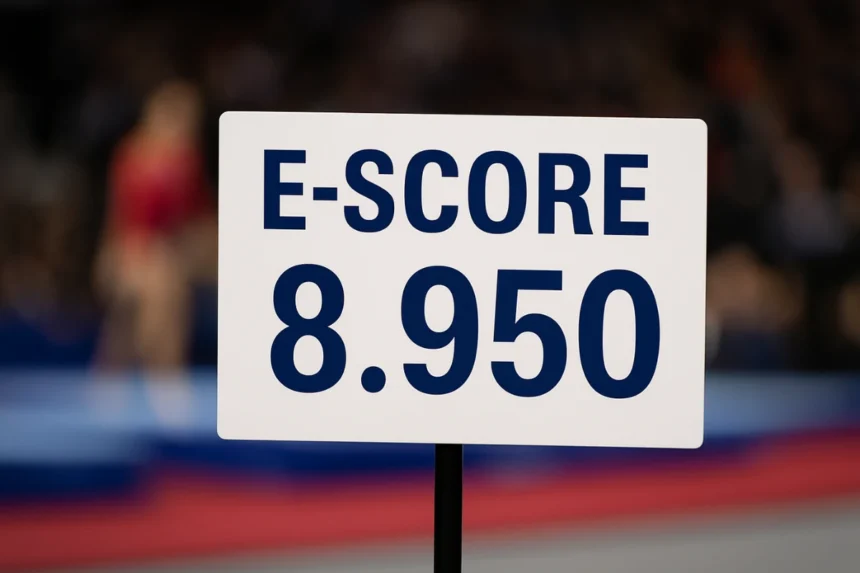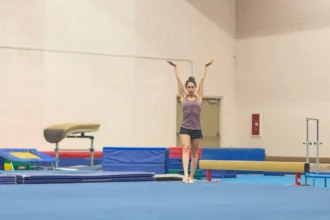In artistic gymnastics, the Execution Score (E-score) reflects how cleanly and artistically a routine is performed. While the D-score rewards difficulty, the E-score rewards quality.
What Is the Execution Score?
Unlike the D-score, which starts at 0.0 and builds up, the Execution Score always begins at 10.0 and goes downward with deductions. Judges then deduct points for form, technique, rhythm, and artistry errors.
- Elite scores (FIG): Top E-scores usually land between 8.0 and 9.3.
- College gymnastics (NCAA): Since routines are capped at 10.0 Start Values, a “perfect 10” is possible when no deductions are taken.
How Judges Compute the Execution Score in Gymnastics
Judges follow a very systematic process to calculate it, ensuring routines are evaluated fairly across all competitions. Here’s exactly how it works.
Step 1: Spotting Faults During the Routine
Judges carefully observe each element of the routine, looking for mistakes in form, posture, and control. Common faults include:
- Bent knees or arms instead of straight extension.
- Legs apart when they should be together.
- Low amplitude (skills not high enough or extended enough).
- Balance checks such as wobbles on beam.
- Steps or hops on landings.
- Deep squat landings with hips dropping too low.
- Touching the mat with hands for support.
- Falls off the apparatus or onto the mat.
Every visible error is noted and classified by size.
Step 2: Assigning a Size to Each Fault
Not all errors are equal. Judges assign a deduction value depending on the severity of the fault:
- Small fault → –0.10
- Medium fault → –0.30
- Large fault → –0.50 (or more for very serious breaks in form)
On top of these, a fall is penalized more heavily:
- FIG competitions (international level) → –1.00 deduction.
- NCAA (college gymnastics in the U.S.) → –0.50 deduction.
These values are applied consistently to keep scoring objective.
Step 3: Adding Deductions and Averaging the Panel
Each judge totals their deductions across the entire routine. For example:
- Small hop on landing: –0.10
- Bent knees in salto: –0.30
- Step forward on dismount: –0.10
Judge’s total deductions: –0.50
Judge’s E-score: 10.0 – 0.50 = 9.50
Since one person’s opinion could be biased or inconsistent, FIG uses a panel system:
- With 5 E judges → drop the highest and lowest scores, average the middle 3.
- With 7 E judges → drop the 2 highest and 2 lowest, average the middle 3.
That final average becomes the gymnast’s official execution score.
Step 4: Mind the “No-Fall Cap”
Under FIG rules, deductions for a single skill are capped at –0.80 if the gymnast does not fall. In other words, even if the element was poorly executed, judges cannot deduct more than 0.80 unless a fall is added on top (–1.00).
This prevents over-deducting when a gymnast struggles but stays on the apparatus.
Putting It All Together
To compute the E-score:
- Judges watch the routine and record faults.
- Each fault is given a deduction size (0.10, 0.30, 0.50, or more for a fall).
- Judges add deductions and subtract them from 10.0.
- A panel average is calculated using FIG’s drop-high/low method.
- The cap rule ensures no single skill without a fall is over-penalized.
The final number reflects how cleanly and beautifully the gymnast executed their routine.
Execution Deductions by Apparatus
| Apparatus | Key Execution Focus | Common Deductions | Deduction Range |
|---|---|---|---|
| Vault | Height, distance, landing | Low or short vault, off-center direction, steps/hops, deep squat on landing | 0.10 – 1.00 |
| Uneven Bars / High Bar | Handstand accuracy, body line, rhythm | Handstands not vertical, leg separations, bent arms/knees, pauses or extra swings | 0.10 – 0.50 (fall = 1.00) |
| Balance Beam | Balance, artistry, precision | Arm wobbles, major balance breaks, poor posture, under-rotated leaps/turns | 0.10 – 1.00 |
| Floor Exercise | Tumbling landings, dance quality, artistry | Hops/steps, out-of-bounds, weak leaps/turns, lack of expression | 0.10 – 1.00 |
| Rings (Men’s) | Stillness, strength holds, handstands | Ring swing, shaky strength holds, poor vertical handstands, extra swings | 0.10 – 0.50 (fall = 1.00) |
| Pommel Horse (Men’s) | Rhythm, leg form, body line | Leg separations, bent knees, hip piking, brushing horse, breaks in rhythm | 0.10 – 0.50 (fall = 1.00) |
| Parallel Bars (Men’s) | Swing amplitude, transitions, dismount | Low swings, bent arms/legs, rough transitions, landing steps | 0.10 – 1.00 |
Artistry Has Its Own Mini-Scale
In the 2025–2028 FIG Code of Points, the Women’s Technical Committee introduced a structured approach to artistry. Previously, artistry deductions could feel vague, but now they mirror the technical ladder:
- 0.10 (small): Slightly flat performance, repetitive movements, or limited expression
- 0.20 (medium): Weak musical connection, little level variation, or choreographic imbalance
- 0.30 (large): No clear artistic intention, poor engagement, or disconnected choreography
This makes artistry more measurable and highlights that performance quality is as important as technical precision.
Source: gymnastics.sport
Combining the E-Score with the D-Score
Once finalized, the E-score is added to the D-score to produce the gymnast’s total.
Final Score = D-score + E-score − Neutral Deductions (if any)
- D-score: Tallies difficulty, composition requirements, and connection bonuses.
- E-score: Reflects execution, artistry, and control, starting from 10.0 and reduced for mistakes.
- Neutral deductions: Penalties unrelated to skill performance (time violations, attire issues, out-of-bounds).
What Makes a High E-Score?
Reaching a strong E-score requires more than just avoiding big mistakes. Judges look for polish, control, and confidence in every movement. Key factors include:
- Clean form: Straight legs, pointed toes, extended body lines, and overall precision.
- Solid landings: No steps, hops, deep squats, or balance wobbles.
- Smooth flow: Routines should connect seamlessly, without pauses, extra swings, or breaks in rhythm.
- Amplitude and power: Skills should look high, light, and confident rather than strained or under-rotated.
Scoring above 9.0 reflects excellent execution with only minor deductions. An E-score above 9.5 indicates a nearly flawless performance.
E-Score Example: Simone Biles Women’s Floor (Paris 2024, Team Final)
In the team final at Paris 2024, Simone Biles performed one of the top floor routines of the Games, blending extreme difficulty with world-class execution.
- D-score (Difficulty): 6.800
- E-score (Execution): 8.066
- Neutral deduction: 0.200 (two steps out of bounds)
- Final Score: 14.666
Breakdown & Interpretation
| Component | Value | Notes |
|---|---|---|
| D-score | 6.800 | Extremely high tumbling and dance element difficulty |
| E-score | 8.066 | Strong execution with only minor form and landing deductions |
| Neutral deductions | 0.200 | Two out-of-bounds steps (0.10 each) |
| Final Score | 14.666 | Formula: D + E − Neutral. A gold-medal-worthy routine |
Even the best gymnast in the world isn’t immune to deductions, two steps over the boundary cost Biles 0.200. But because her E-score stayed above 8.0 despite tiny faults, and her D-score was one of the highest in the field, her routine remained unbeatable.
At this level, the combination of sky-high difficulty and controlled execution is what makes the difference between a strong score and a historic one.






